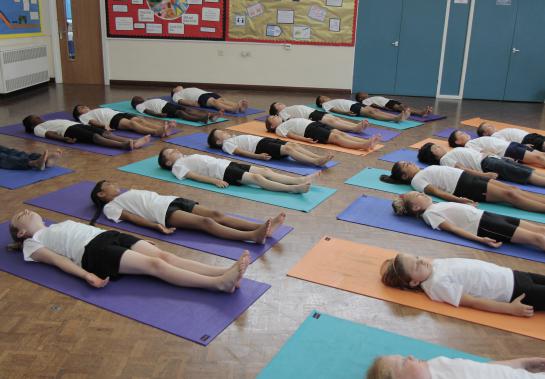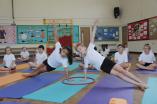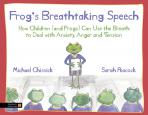Everyone Included in the Yoga Lesson. Anita's Story


Introduction
Teaching yoga as part of the integrated school day in primary schools means that I face classes of around thirty children in each lesson. Sometimes, within the thirty, I am teaching a child who has a severe physical impairment which disallows him or her from performing the posture in a conventional way. How do I make sure that everyone is included?
Here is the story of Anita, who was as much part of the yoga class as anyone else. As you read her story consider two things:
- What is the likelihood of Anita attending an after school yoga club?
- Where will Anita feel safest, supported and included?
Background

Anita has spinae bifida. When I taught her she was a Year 4 pupil at a mainstream primary school in Essex. Anita transferred from her wheelchair to her walking frame before the yoga lesson and was assisted by her Learning Support Assistant (LSA)
Anita could support herself on one leg within the safety of the frame, holding on with one arm. She could also sit and support herself on the yoga mat independently. She was highly intelligent, articulate and a very determined child. I taught Anita and her class for three years. Over that time her posture work improved considerably, especially her balancing, and this contributed to her soaring confidence.
My Main Focus 

Whilst I am a specialist children’s yoga teacher, the main focus of my work with children centres on the social and emotional aspects of learning. The foremost aim in every lesson is to enhance children’s self esteem. Other benefits like improved flexibility, fitness, better concentration and calmness, for example, are natural when you practice yoga, yet combined with the emphasis on the aspects of social and emotional learning contribute to a powerful increase in the child’s sense self worth.

Aims for Anita
Anita's Class Teacher and I decided our Aims would be to:
- Include Anita in all activities
- Teach Anita a variety of yoga postures
- Encourage Anita to balance on one leg without holding the frame
Our Approach

I adapted all the postures and activities so that the Anita could do what the rest of the class could do. This meant that Anita was immediately included while the other children were not held back from stretching to their potential.

 The lesson was split into two parts. In the first part the children were taught and performed Standing Postures and in the second Sitting or Floor Postures. In this way Anita avoided the constant ups and downs which she found difficult and time consuming.
Standing Postures
Most of the standing postures involve balances, which are great for improving concentration and focus.
Over the time that I taught Anita we encouraged her to stand in an adapted Tree Posture within the walking frame but without the support of the frame. Whilst this was not easy, Anita’s determination helped her to a victory eventually, a victory that was shared with her class who were in no doubt what she had achieved.
Anita and all the class particularly enjoy the Sneaky Trees Game in this section. This is a game based on grandma’s footsteps and reinforces the Tree balance. Not only was Anita fully included in the posture but she was involved in the fun of the game as well.
Sitting Postures

Sitting on the mat Anita was not reliant upon the support of her legs. Here she was able to perform Twists and any of the many seated postures that I teach as well as anyone else. One of the class’s favourites is the Flower Game. Children do need to move around in the game and they are given the choice of walking or sliding on their bottoms. Anita, naturally, found that she could get about by the sliding method. Thus again she was included in the fun of the game as well as the posture work.
Sequences

Sequences are highly effective in the Yoga at School lesson for several reasons:
- Sequences demand concentration and co-ordination
- Children enjoy the flowing body movements
- It is a more invigorating way to practice yoga compared to isolated postures
- Children find sequences easy to remember and can teach them to friends and family members


The most popular sequence that I teach is called the Sun Sequence. Adapted from the adult version to suit children, it is normally performed from a standing position. It is considered to be an all inclusive yoga activity, because it involves all the basic body movements such as forward and back bends as well as side stretching.
Working from standing would obviously be very difficult for Anita. Therefore I adapted the sequence to be performed from sitting without loosing any of the basic body movements or vitality of the activity. In this way Anita and the whole class were involved, included and were all able to gain the benefits that practicing sequences yield.
Relaxation
I teach children simple yet effective relaxation techniques. Relaxation relaxes muscles, improves breathing, refreshes and invigorates the body, helps children cope with anxiety and become calmer.

Apart from some blocks supporting at the back of the knees, Anita was able to relax in the supine posture. Anita and the class - and especially the class teacher - looked forward to this part of the lesson enjoying the opportunity for peace and quiet that is often rare in a child’s life
Summary

By adapting postures and planning whole class activities that included Anita we achieved our goals. At the same time it was clearly noticeable that:
- Class unity was enhanced
- Anita experienced a great sense of success
- Some other children who normally did not enjoy physical activities like PE were happily involved in the yoga lesson
- The whole class was challenged
Conclusion
Anita would not have had the crucial support of the class teacher or her LSA at an after school club. This is yet another example to support the case for yoga to be taught in schools as part of the integrated school day on an ongoing basis.
Anita is special because she was the first of many children that I have since taught in mainstream primary that find it difficult or impossible to stand. In truth teaching children like Anita is challenging and a little scary. The results, however, prove that planning how to adapt postures and activities is so worthwhile.
(c) Copyright 2017 Michael Chissick & Yoga at School. Not to be reproduced or distributed without permission






